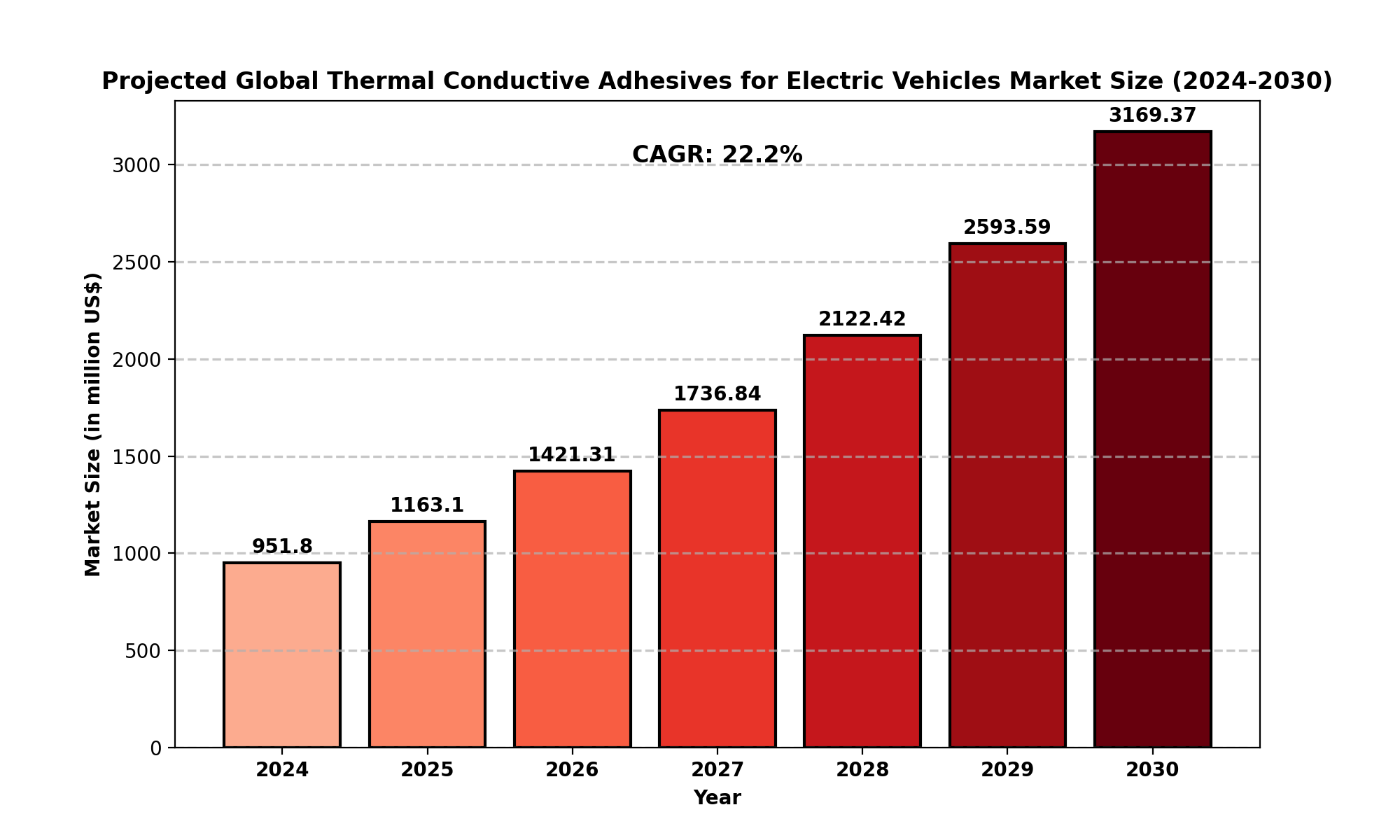TOP CATEGORY: Chemicals & Materials | Life Sciences | Banking & Finance | ICT Media
Thermal Conductive Adhesives for Electric Vehicles (EVs) refer to specialized bonding materials designed to efficiently transfer heat from one component to another within EV systems. These adhesives are essential in maintaining thermal stability, preventing overheating, and ensuring the longevity of sensitive electronic components. They are typically formulated with thermally conductive fillers, such as silicone, polyurethane, or other materials, and are widely used in applications like power battery packs and electronic control systems.
The global Thermal Conductive Adhesives for Electric Vehicles market was valued at US$ 951.8 million in 2024 and is projected to reach US$ 3169.3 million by 2030, growing at a robust CAGR of 22.2% during the forecast period.
This substantial growth is driven by the increasing adoption of electric vehicles globally, advancements in adhesive technologies, and the need for efficient thermal management systems in EVs.
Key Statistics
2024 Market Value: US$ 951.8 million
2030 Market Value: US$ 3873.4 million
CAGR (2024-2030): 22.2%

Drivers
Increasing EV Adoption: The rapid growth of the EV market is driving the demand for thermal conductive adhesives to manage heat effectively in battery systems and electronic components.
Stringent Environmental Regulations: Governments worldwide are enforcing strict regulations to reduce carbon emissions, further encouraging the adoption of EVs and related technologies.
Technological Advancements: Innovations in adhesive formulations, such as improved thermal conductivity and enhanced mechanical properties, are boosting market demand.
Restraints
High Initial Costs: The development and application of advanced thermal conductive adhesives involve significant costs, posing a challenge for widespread adoption.
Material Limitations: Some adhesives face limitations in terms of performance under extreme temperatures, restricting their use in certain EV components.
Opportunities
Emerging Markets: Growing EV adoption in emerging economies like India and Southeast Asia presents lucrative opportunities for market players.
Collaborations and Partnerships: Partnerships between adhesive manufacturers and EV companies can lead to the development of tailor-made solutions, driving market growth.
Challenges
Competition from Alternative Technologies: Other thermal management solutions, such as thermal pads and greases, compete with adhesives in the market.
Supply Chain Disruptions: Fluctuations in raw material availability can hinder production and impact market growth.
North America
The U.S. market is expected to witness significant growth due to increasing EV adoption and technological advancements in adhesive materials.
Europe
Leading markets like Germany, France, and the UK are driving growth through robust EV manufacturing and stringent environmental policies.
Asia-Pacific
China and India are anticipated to dominate the market due to large-scale EV production and government incentives promoting electric mobility.
Middle East and Africa
While the market is in its nascent stage, increasing EV infrastructure development is expected to fuel growth in this region.
South and Central America
Countries like Brazil and Argentina are emerging markets with growing interest in sustainable transportation solutions.
Key Players
Henkel AG & Co. KGaA
H.B. Fuller
Dow
3M Company
Sika
Parker Hannifin
Huntsman
Wacker Chemie
These companies collectively hold a significant share of the global market, leveraging their expertise in material science and strong distribution networks to maintain a competitive edge.
Market Segmentation (by Type)
This report includes detailed profiles of major players, highlighting their market share, product portfolios, and strategies. The competitive analysis helps stakeholders understand the market dynamics and identify growth opportunities.
The report provides a comprehensive breakdown of the market by region and country, offering insights into demand patterns, growth trends, and key players in each region.
What is the current market size of the Thermal Conductive Adhesives for Electric Vehicles market?
Which are the key companies operating in this market?
What are the key growth drivers in the market?
Which regions dominate the market?
What are the emerging trends in the market?
Chapter 1: Introduces the definition of Thermal Conductive Adhesives for Electric Vehicles, market overview.
Chapter 2: Global Thermal Conductive Adhesives for Electric Vehicles market size in revenue and volume.
Chapter 3: Detailed analysis of Thermal Conductive Adhesives for Electric Vehicles manufacturers competitive landscape, price, sales and revenue market share, latest development plan, merger, and acquisition information, etc.
Chapter 4: Provides the analysis of various market segments by type, covering the market size and development potential of each market segment, to help readers find the blue ocean market in different market segments.
Chapter 5: Provides the analysis of various market segments by application, covering the market size and development potential of each market segment, to help readers find the blue ocean market in different downstream markets.
Chapter 6: Sales of Thermal Conductive Adhesives for Electric Vehicles in regional level and country level. It provides a quantitative analysis of the market size and development potential of each region and its main countries and introduces the market development, future development prospects, market space of each country in the world.
Chapter 7: Provides profiles of key players, introducing the basic situation of the main companies in the market in detail, including product sales, revenue, price, gross margin, product introduction, recent development, etc.
Chapter 8: Global Thermal Conductive Adhesives for Electric Vehicles capacity by region & country.
Chapter 9: Introduces the market dynamics, latest developments of the market, the driving factors and restrictive factors of the market, the challenges and risks faced by manufacturers in the industry, and the analysis of relevant policies in the industry.
Chapter 10: Analysis of industrial chain, including the upstream and downstream of the industry.
Chapter 11: The main points and conclusions of the report.